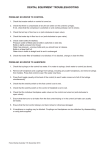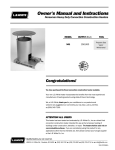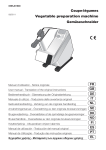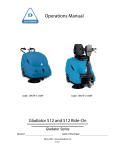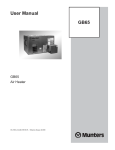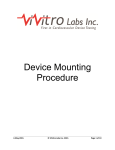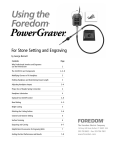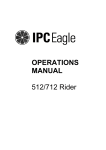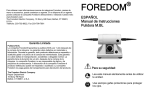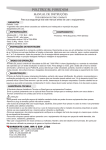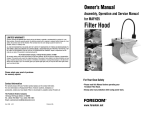Download Series K - Foredom
Transcript
Contents Owner's Manual Safety Instructions Assembly, Operation, and Service Manual for Page 2 The Series K 3 Assembly Instructions 4 Assembly & Adjustment of Shaft, Sheath & Handpiece 4 Connecting Foot Speed Control 5 Attaching Accessories 5 General Accessory Recommendations 7 Operation 9 Maintenance Series K Ball Bearing Power Tool and Handpieces Routine Cleaning & Lubrication 10 Replacement of Motor Brushes 10 Replacement of Worn Shaft and Sheath 10 Handpiece Lubrication 10 Other Service and Repair 11 Recommended Spare Parts & Supplies 11 Limited Warranty 12 Owner’s Registration Card 12 For More Information 12 For Your Own Safety: Safety Instructions • Read Owner's Manual before operating your Foredom power tool. • Always wear eye protection while using power tools. • Only use accessories with the same or higher speed ratings as your power tool (18,000 RPM). Before using your Foredom® power tool, please read safety instructions. They are for your protection and should always be followed to reduce the risk of personal injury or damage to the tool. Always wear proper eye and face protection. Safety glasses or face shields should be worn whenever you operate a Foredom or any power tool to prevent serious eye or face injuries. Do not wear loose fitting clothing or jewelry. Loose clothing or jewelry can become entangled in the rotating flexible shaft. Do not wear items such as neck ties, necklaces, or bracelets when operating power tools. Be sure to tie back or secure long hair. Secure power tool to motor hanger or work surface. Flexible shaft power tools can vibrate during operation. The tool should be properly secured in order to prevent it from vibrating off of the motor hanger or work bench. Never operate any accessory at speeds above it’s maximum rated speed. When properly used, all of Foredom's accessories can be operated at the speed ratings listed in the Foredom Accessory Catalog or on the accessory kits and packages. Always find out the manufacturer's speed rating before using accessories other than Foredom accessories. • • • FOREDOM power tools ® • 2 • Never use or continue to use any accessory which appears to be damaged, loose, vibrating, or out of balance. Inspect each accessory for cracks or flaws before using it. • Always insert the shank or arbor of an accessory or mandrel into the collet or chuck of the handpiece as far as possible in order to provide proper support and tighten the collet or chuck securely. • Never use excessive side pressure which may tend to bend or break the shank or arbor of an accessory. Let the speed of the accessory do the work. • Do not stall the motor by jamming or using excessive pressure on the accessory. This can result in damage to the motor or flexible shaft. • Never operate the motor with the outer sheath removed from the flexible shaft. • Always disconnect the power cord before servicing the motor or removing the flexible shaft or sheath. • Never operate your power tool during a perceptible power decrease. Turn power tool off and do not use until power is fully restored. • Use proper grounding procedures. This tool should be grounded while in use to protect the operator from electric shock. The tool is equipped with an approved 3-conductor cord and plug to fit the proper grounding receptacle. Assembly Instructions Always make sure your power tool is unplugged during assembly! After identifying all the components of your power tool, it should be assembled in the following manner: Assembly and Adjustment of Flexible Shaft, Sheath & Handpiece Proper assembly and adjustment of the flexible shaft and sheath are critical for the correct operation of your Foredom power tool. Important Note: The shaft and sheath should be checked and adjusted if necessary even if you received them assembled and attached to the motor! Please follow the directions below to assemble and adjust the shaft and sheath and attach the handpiece. Assembly: 1.Remove the motor connector (see figure 1). This has a left hand thread and must be turned to the right to remove. 2.Loosen the set screw on the flexible shaft motor coupling and slide the shaft coupling onto the motor shaft. Tighten the set screw onto the flat in the motor shaft. The Series K 3.Put the motor connector back on the motor by sliding it up the flexible shaft and tightening. Grease shaft (see page 12). You have purchased a quality power tool which will perform a wide variety of tasks difficult to do with any other kind of power tool. Foredom power tools are manufactured to high standards of precision and performance and, with proper use and regular maintenance, will give you years of trouble-free performance. 4.Now slide the sheath over the flexible shaft with the plain sheath fitting (not the grooved fitting) going toward the motor and into the motor connection. A complete Foredom flexible shaft power tool consists of a motor, flexible shaft and sheath, speed control (foot or manual), and a handpiece. Locate and identify all components, parts, and accessories you purchased before discarding the packing list and packing materials that came with your power tool. This instruction manual contains instructions for the assembly, operation, and servicing of the Foredom power tools shown at right. Series K Motor 19mm Adjustment: FCT2-CE Foot Speed Control 3 5.Before attaching handpiece, shaft and sheath adjustment must be carefully checked. Place the entire unit on a flat surface with shaft and sheath extended straight. Adjust the exposed tip of the flexible shaft so that it extends 19mm beyond the sheath, as shown in diagram above. This is done by moving the sheath in or out of the motor connector. When the correct adjustment is made, tighten the screw in the motor connector. 4 Attaching Handpiece: 6. Finally, attach the handpiece by pushing it on the grooved QD (quick disconnect) fitting on the sheath. Be sure that the keyed tip of the flexible shaft is properly lined up with the slot in the handpiece shaft connector by looking into the rear of the handpiece before pushing it on. If it is not in line, turn the shaft tip or the handpiece to the correct position. Connecting Foot Speed Control Connect the foot control to the motor by inserting the 3-prong plug on the end of the motor power cord into the socket connector on the shorter power cord on the foot control. Insert the plug on the longer power cord from the foot control into a proper 3-wire power outlet. Foredom Handpieces 7A 25 7AD 25C 8 28 8D 30® 10 35 15 18D General Directions: Be sure to use the correct shank size. The correct shank will fit snugly inside the collet. Caution: Never tighten a collet unless an accessory has been inserted. Tighten an empty collet or inserting an accessory which is too small or too large may damage the collet. Nos. 8, 8D Handpieces: Pull back chuck guard sleeve to uncover the lower portion of the spindle hole. Insert pin or wrench provided into the spindle hole or grip lower spindle with wrench. Loosen chuck nut. Insert accessory shank as far as possible into the collet. Tighten chuck nut. Test for a secure hold by pulling on accessory. Pull out pin or release grip on spindle. To release an accessory, follow the same steps. Accessories can be released when chuck nut is ready to be loosened. If accessory does not run true, loosen chuck nut, rotate accessory, and retighten. To change the collet, simply unscrew the chuck nut and slip out collet. Slip in new collet and screw chuck nut back in place. No. 28 Handpiece: The No.28 comes with a pin and wrench for opening and closing the collet. To open the collet, insert the pin through the hole in the handpiece and the spindle and loosen the chuck nut with the wrench. Insert the shank of the accessory as far as it will go into the chuck nut and collet, then tighten the chuck nut securely with the wrench. Remove the pin from housing before starting the flexible shaft machine. Nos. 25, 35, and 44T Handpieces: To insert or exchange accessories, insert pin provided into the pilot hole and through the spindle hole (turn spindle to align holes). Loosen chuck nut slightly with wrench provided. Insert shank of accessory into collet. Tighten chuck nut with wrench, keeping pin in pilot hole. Test for a secure hold by pulling on accessory. Remove pin. These handpieces have Jacob's type chucks. Open chuck jaws as far as necessary with key provided. Insert shank of accessory into the chuck as far as possible. Tighten jaws with chuck key until accessory is secure and centered. If accessory does not run true, reopen jaws, rotate accessory and retighten. To release accessory, simply reopen chuck jaws with key and pull out accessory. 44T 18 Collet Types Chuck Type — Nos. 25C, 30® Handpieces: 10D 15D Attaching Accessories to Handpieces Directions for attaching accessories to handpieces vary according to the type of handpiece being used. Locate the model number of your Foredom handpiece from the illustrations on page 5. Attach the accessory according to the following directions: 52 Hammer Type — Nos. 15, 15D Handpieces: These handpieces have a threaded spindle. Thread anvil or stylus into threaded spindle as far as it will go with clockwise motion. Insert pin provided into cross hole in anvil or stylus. Tighten and remove pin. To release accessory, insert pin into the cross hole and unthread 52D 53 5 Latch Type — Nos. 55A, 55D, 56A, 56D Handpieces: These handpieces have simple finger latches. Slide the latch over and insert the shank of the accessory as far as possible. Slide the latch back into place. 6 Test for a secure hold by pulling on the accessory. To release the accessory, slide latch out again and pull out accessory. Quick Change Type Nos. 7A and 7AD Handpieces: These handpieces have a push-pull collet closer. Pull the handpiece grip back as far as it will go. Insert accessory shank (size 2.35mm only) as far as it will go. Push front portion of the handpiece forward firmly. Test for a secure hold by pulling on the accessory. To release accessory, pull handpiece grip back with firm pull. Pull out accessory. Nos. 10 and 10D Handpieces: These handpieces operate only when a 2.35mm shank bur is inserted. It will lock if bur is not inserted. To insert bur, move lever 180º clockwise towards the back (shaft connection end) of handpiece. Insert or change a 2.35mm shank bur and move lever 180º forward. Make sure lever is completely locked into the forward position. Nos. 18 and 18D Handpieces: These handpieces have a lever on side of handpiece. Push the spring loaded lever in to open collet and release the shank of accessory (2.35mm only). Insert accessory while holding the lever down with thumb or finger. Never push lever down while handpiece or flexible shaft are rotating. Nos. 52, 52D, and 53 Handpieces: These quick change handpieces have a unique push/pull collet chuck release mechanism for rapid accessory changing (2.35mm only). Wait for the motor, flexible shaft, and accessory to come to a full stop before opening the chuck. After accessory has stopped rotating, pull the outer grip forward with one hand while holding the back of the handpiece with the other. Remove the accessory and insert the shank of the new one at least 1″ (25mm) into the chuck. Pull the grip all the way back until the chuck snaps closed. Be sure to read the following accessory recommendations before using your Foredom Power Tool. General Accessory Recommendations The wide assortment of Foredom accessories makes your flexible shaft power tool very versatile. Grinding, sanding, brushing, cutting, buffing and polishing can all be easily accomplished. Choose the right accessory for your special needs by referring to the Foredom Accessory Catalog No. 350. Accessories may be purchased through your local dealer or by contacting: The Foredom Electric Company, 16 Stony Hill Road, Bethel, CT 06801, (203)792-8622. Always let the speed of the power tool do the work. Avoid forcing the tool or applying too much pressure. Experience will help you choose the right speed for the work you are doing. It's always a good idea to practice on a scrap piece of the same material you plan to work on to determine the best accessories and speeds to use. Always follow the manufacturer’s RPM or speed recommendations when selecting accessories. Your Series K motor is supplied with a variable speed control so that you can operate it at the most suitable speed for each job. The motor has a maximum speed rating of 18,000 RPM. Always use an accessory which has the same or a higher rating than your tool. Using an accessory with a lesser rating can result in serious injury. 7 1. Abrasive Points, Wheels and Discs: Use Silicon Carbide (green color) for low-tensile, brittle or “smeary” types of metals such as aluminum or brass. Use Aluminum Oxide (red color) for fast cutting on high-tensile, tough materials such as steel and malleable iron. Also use on glass and porcelain, etc. Aluminum Oxide (white color) points have an extremely fine grit for producing a fine, high finish on high-tensile materials including gem stones, stainless steel, and glass. Rubber Bonded Abrasive Wheels are used for removing rust and for polishing with various grits. For best results, use finer grits for finishing at high speeds and coarser grits for stock removal at lower speeds. New CeramCut Blue Stones are made from a mixture of special man-made ceramic grain and aluminum oxide bonded together. The ceramic grain provides a faster cutting action and is more durable so that shapes are maintained longer than pure aluminum oxide stones. TM 2. Burs and Cutters: Vanadium Steel Cutters are suitable for all materials except hardened steel and glass. Use Carbide Burs on such materials as wood, plastic and tough alloys (Carbide is generally referred to as the “hardest man-made metal”). Engraving Burs are used for fine detailed work on metal and other hard materials. Generally, use medium speeds for stock removal. Higher speeds are required for finishing work and for the smaller points. Typhoon Carbide Burs are specifically made for use on soft and hard woods and plastics. TM 3. Sanding Drums, Bands and Discs: These accessories are used for removing rust, smoothing rough surfaces and for sanding jobs on wood, plastic and metal. (Avoid using too much pressure which will cause clogging or a build-up on the work surface.) For best results, use medium speeds for coarser grits and larger diameters. Use higher speeds for finishing work or with smaller sizes. 4. Cotton or Felt Bobs and Buffs: Solid Felt Buffs or Bobs are used in combination with gritty or smooth compounds for a variety of buffing and polishing operations on plastic, wood, and metal. They vary in shape and come in three hardnesses — medium, hard, and rock hard. Loosely-stitched Soft Cotton Buffs are used for delicate work; especially work with precious metal and during polishing operations. Generally, use high speeds for cutting down and buffing. Medium speeds are used for delicate, precise work and for polishing. 5. Brushes: Miniature power brushes are generally used on metal surfaces and hard-to-reach areas. They are ideal for deburring, surface finishing, edge blending, roughening to create a good bonding surface, and general cleaning. Use high speeds for cleaning and deburring. Medium speeds are needed when cleaning hard-to-reach areas and edge blending. 6. Diamond Burs: Diamond Burs are used to remove stock from extremely hard materials such as tungsten and tantalum carbide cutting tools, dies and molds, broaches, and for lapping and polishing synthetic jewels and precious metals, fiberglass and reinforced plastics, PVC and ceramics. 8 Operation Maintenance Read all the safety instructions in this manual before operating any Foredom Power Tool. Proper eye and face protection must be worn to protect you from injuries caused by flying debris, chips, or sparks which might result from the work being done. It is very important to routinely clean and lubricate your Foredom Power Tool, especially in areas that generate a lot of dust. Dirt and improper lubrication are the most common causes of poor operation and excessive wear. Always disconnect power tool before cleaning or servicing. Your Foredom motor may be operated in a vertical or horizontal position, but it should not be enclosed or confined so as to restrict air circulation. If the motor is hung up above a workbench, be sure it is fastened securely to the wall or motor hanger. The motor may develop a high operating temperature (up to 100oF + ambient) after prolonged use, and it will be too hot to hold. This will not harm the motor which is designed to operate at this temperature for prolonged periods. Follow these guidelines for trouble-free use: a 4″or larger radius, as shown to the right, should be maintained for shafts on all motors. In its normal curved position, the Series H can withstand 28 lbs. of torque before breaking. All other Series can tolerate up to 12 lbs. of torque. There is no way to avoid ultimate wear and under normal conditions a flexible shaft machine may require several replacement shafts and sheaths during its lifetime. (Follow shaft and sheath assembly instruction in the Assembly section of this manual.) Do not force the tool Do Not Do This! 1. Routine Cleaning of Universal Motors Universal Motors need air circulation through the motor housing to remove waste heat and cool the windings. Inlet and outlet slots provide the means for air flow. However, dust and conductive debris (like metal filings and gold dust) can enter in through these slots. If not cleaned regularly, dust could collect, making a bridge between parts, causing an electrical short. Therefore, in high dust environments, Foredom recommends cleaning the motor every 40 hours of use. To remove dirt/dust buildup, brushes should be removed, cleaned and replaced, and air should be blown through the motor. 2. Routine Cleaning and Lubrication of Flexible Shaft The flexible shaft should be cleaned and lubricated once every 50 hours of use. Expose the shaft by removing the handpiece and then the sheath. Apply a light film of Foredom flexible shaft grease (Part No. 10006) along the entire length of the shaft. Replace the sheath according to instructions in the Assembly and Installation section of this manual. Once every 200 hours, the shaft should be thoroughly cleaned with a solvent and lubricated. 3. Replacement of Motor Brushes The motor brushes should be check for wear periodically. When new, they are approximately 19mm long. They should be replaced when they have worn to 6mm. To remove brushes, disconnect motor power cord and unscrew the brush caps. Be sure that the contour of the brush matches the armature when replacing them. Minimum Operating Radius 4. Replacement of Worn Shafts and Sheaths Be sure to disconnect your power cord before servicing. Shafts and sheaths last longer when they are used at a straight angle. If used at sharp angles or loops, wear will occur at the points of greatest friction. There is no way to avoid ultimate wear, and under normal conditions a flexible shaft machine may require several replacement shafts and sheaths during its lifetime. Follow replacement instructions in Assembly section of this manual. 4″ radius 4″ radius Do not bend at tight angle. Shafts and sheaths last longer when they are used without sharp bends. If used at angles or loops, wear will occur at the points of greatest friction. When operating your power tools be careful not to bend the flexible shaft too much at either the handpiece or motor shaft connections. Excessive heat and wear will occur if the bend is too great. Note: Ball Bearing Motors do Not Require Lubrication. Let the speed of the tool do the work. Avoid using too much pressure. Generally, slower speeds are used for rougher, heavier work or when greater control over the accessory is required for precise, delicate work. Higher speeds are used for buffing, cutting and polishing. Read Accessory Recommendations on page 7 of this manual. 5. Handpiece Lubrication (See page 5 for handpiece photos.) Numbers 7A and 7AD*: Unscrew the front housing which exposes the spindle. Clean the spindle thoroughly with solvent. Apply several drops of Foredom oil (part nos. 10005 or 10010) to the spindle and spread it over the spindle uniformly. This should be done each 20 hours of operation. Voltage Decreases Never operate a power tool during a perceptible power decrease. Turn off tool and unplug until full power is restored. Numbers 8, 8D*, 18, 18D*, 25, 25C, 30®, 35, and 44T: These handpieces have been permanently lubricated with greased-shielded ball bearings and should absolutely not be lubricated. Always wear proper eye and face protection when operating 9 10 Number 10: Lubrication should not be required for the first 2-3 months of continuous use. Then, approximately every two weeks, remove the sheath connector (it has a standard right hand thread) to expose the slotted shaft connector and back of handpiece spindle. Clean off any dirt or old lubricant. Apply 1 or 2 drops only of Foredom oil to the spindle where it attaches to the slotted shaft. Now replace sheath connector. Number 10D* Handpiece with Duplex Spring Connection: Approximately every 20 hours of operation apply 1 or 2 drops of Foredom oil into the hole in the duplex spring collar next to the sheath connector. This will provide sufficient lubrication for both the duplex spring connection and the handpiece spindle. Numbers 15 and 15D*: Before disassembling, clean off any dirt to prevent foreign matter from falling inside the handpiece. Remove the threaded nosepiece assembly carefully with wrench supplied by turning counterclockwise (right-hand thread). Put two drops of Foredom oil into the bottom of the threaded hole of the housing and one drop into the nosepiece assembly. Replace the nosepiece assembly, hold the handpiece upright and run it slowly to distribute the oil. Lubricate every 100 hours of use. Send your Owner's Registration Card to Foredom right away. We will keep your card in our Registration and Serial Number File. Repair Services Authorized repair service is available at the Foredom factory in Bethel, CT. Send items for repair to the factory marked “Attention: Repair Department”. Enclose the item(s), a packing list, and information regarding the problem or repairs required. Estimates of repair cost will be made upon request. It is our policy not to proceed with a repair without your approval if the cost (labor plus parts) is more than fifty percent of the cost for a new replacement. You will be notified by mail and advised of the cost to repair and to purchase a new replacement. Please allow three business days for an estimate to be done and five to seven business days for repair work to be completed after we receive your approval to proceed. Series K Ball Bearing Motor LIMITED WARRANTY Foredom warrants the Series K Motor to be free of defects in material or workmanship for a period of 1 year after purchase. During the warranty period, the defective product will be repaired or replaced without charge or, at our option, the purchase price will be refunded. This warranty does not cover damage caused in transit or by accident, misuse, or ordinary wear. Handpieces 52, 52D, 53: These handpieces do not require any lubrication. Putting oil or grease into the front or back of these handpieces will damage their prelubricated ball bearings. *Note: All handpieces marked with asterisk have duplex spring connections (flexible springs in middle). These connections must be lubricated once every 20 hours of operation. Apply about two drops of oil into the hole on the rear of the connection collar. This should be done with Foredom Hypodermic type oiler (Part No. 10005). Other Service and Repair All other service and repairs should only be done by a professional repair person or shop. Your dealer can help you select one or can arrange to have your Foredom equipment returned to the Bethel, CT factory. (See Repair Service section in this manual.) Storage Store your Foredom power tools in a DRY, clean, dust-free area. Store out of the reach of children. Recommended Spare Parts and Supplies for Series K The following parts and supplies are recommended as spares to keep on hand to insure continuous operation of your Foredom power tool. 1 1 1 1 Owner's Registration Card flexible shaft (Part No. 93) pair motor brushes (Part No. 2019) Foredom flexible shaft grease (Part No. 10006) Neoprene Sheath (Part No. 77N) ALL IMPLIED WARRANTIES, INCLUDING BUT NOT LIMITED TO WARRANTIES OF FITNESS AND MERCHANTABILITY, ARE HEREBY LIMITED IN DURATION TO A PERIOD ENDING 1 YEAR FROM DATE OF PURCHASE, AND WE WILL NOT BE LIABLE OR RESPONSIBLE FOR ANY SPECIAL OR CONSEQUENTIAL DAMAGES. Repair or replacement will be made at our option if the product is returned post-paid to: The Foredom Electric Company 16 Stony Hill Road Bethel, CT 06801 All warranty repairs must be done at the factory at the above address. We will not pay any shipping or transportation charges. The #76 Duplex Spring is not covered by this warranty since it is especially sensitive to the pressure and stress variables of the individual operator.This warranty only covers the original purchaser of the product. Some states do not allow limitations on how long an implied warranty lasts or the exclusion or limitation of incidental or consequential damages so the above limitations may not apply to you. This warranty gives you specific legal rights, and you may also have other rights which vary from state to state. For More Information For more information on Foredom machines, handpieces or accessories, contact your local dealer. When no local dealer is available, write, call or fax: The Foredom Electric Company, 16 Stony Hill Road, Bethel, CT 06801 (203)792-8622, Fax: 203-796-7861. Visit on line at: www.foredom.com FOREDOM ® THE FOREDOM ELECTRIC CO. Bethel, CT 06801 11 Form 1267 2/03 b Printed in U.S.A.







